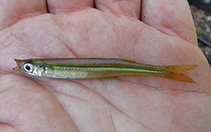| Family: |
Atherinopsidae (Neotropical silversides), subfamily: Menidiinae |
| Max. size: |
6.42 cm SL (male/unsexed) |
| Environment: |
pelagic-neritic; freshwater |
| Distribution: |
North America: known from the drainages of the Gulf of Mexico (from the Neches River, including the Lower Mississippi River) and east around the southern tip of peninsular Florida and north to the Pee Dee River drainage. |
| Diagnosis: |
Dorsal spines (total): 4-7; Dorsal soft rays (total): 8-12; Anal spines: 1-1; Anal soft rays: 18-26. This species is distinguished and differs from L. sicculus by the following characters: Labidesthes vanhyningi have the anterolateral processes of the posttemporals
shorter than width of the base (vs. L. sicculus having the processes longer than width of base); with a midlateral stripe that does not taper, usually expanding, to insertion of pectoral fin in advance of the first dorsal-fin (vs. tapering to insertion of pectoral fin in advance of first dorsal fin); a ratio of thoracic length to abdominal length less than 2 (vs. greater than 2) (Ref. 104856). |
| Biology: |
|
| IUCN Red List Status: |
Not Evaluated (N.E.) Ref. (130435)
|
| Threat to humans: |
harmless |
Source and more info: www.fishbase.org. For personal, classroom, and other internal use only. Not for publication.

